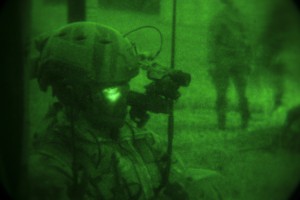2016-01-10 Recently, during an exercise in Japan, the USMC worked an interoperability force insertion effort with various Marine Corps units working together with the participation of a USAF JTAC.
According to a story by Cpl. Thor Larson published on 12,27,15:
CAMP HANSEN, OKINAWA, Japan – It’s the middle of the night helicopters fly overhead, Marines surround a house and the loud crack of a flashbang goes off while a voice booms through a megaphone.
“Come out now and you will be treated kindly, if not you are putting your life at risk!” Slowly a few people start to come out of the house, but not everyone does and the Marines are forced to go in. The Marines stack up on a door and rush into the house and the quiet cracks of suppressed weapons fill the air as the Marines take over room-by-room.
The Marines with Maritime Raid Force, 31st Marine Expeditionary Unit, conducted two raids on simulated high value targets during Interoperability Exercise 16-1 on Camp Hansen, Okinawa, Japan, Dec. 6-16, 2015.
The missions during INTEROP are used to provide realistic mission sets and environments the MRF could be tasked with while a part of the 31st MEU.

“INTEROP is the first opportunity the Force Reconnaissance Platoon, Amphibious Reconnaissance Platoon, and the Rifle Platoon from the Battalion Landing Team have to combine as the Maritime Raid Force on the 31st Marine Expeditionary Unit,” said Capt. Joshua Chambers, the commanding officer of MRF, 31st MEU.
INTEROP brings together all of the elements of the MRF and the MEU so they can identify any deficiencies, work through them and build standard operating procedures, according to an assistant team leader with the MRF.
INTEROP provides the most realistic training possible for the MRF, according to Chambers. The raids were designed to be as realistic as possible, from the planning to the execution.
To begin the planning process for a raid, the MRF first starts with a reconnaissance and surveillance mission. The R&S mission is used to gather information about the area to include weather, terrain and threats.
The R&S mission is used to decide how and when the raid takes place, according to Cpl. Bryan Loos, an MRF intelligence analyst. The information gathered determines what equipment and what time the MFR decides they need to conduct the raid to be most successful.
After the R&S mission is complete, the MRF and the MEU begin planning together. Joint planning allows them to coordinate any additional assets they may need for the raid, like air support or additional security.
“(INTEROP) allows the 31st MEU to understand what support the MRF needs and how to support them during missions,” said Chambers. “Each unit is capable of operating independently, but INTEROP allows the MRF to fuse together with the MEU both operationally and procedurally to build a better team.”
When all the planning is complete, the MRF Marines are told when and where to be and what equipment they will need, according to Loos. They get one final conformation brief to let everyone involved know of any changes before beginning their missions…..
https://www.dvidshub.net/news/185357/maritime-raid-force-breaches-into-interop-16-1#.VpJRzDb_s7k

